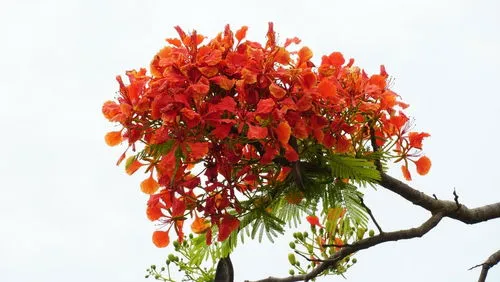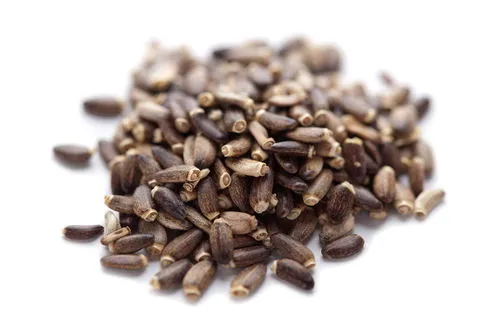The Enchanting Gulmohar Flower: A Comprehensive Guide
The Gulmohar tree, one of the world’s most beautiful tropical plants, is a sight to behold. With its large, blossoming flowers and light aroma, this deciduous tree is a favorite in many parts of the world, especially in India. Despite its origins in Madagascar, the Gulmohar thrives in India’s tropical climate, making it a beloved outdoor plant.
What is the Gulmohar Tree?
The scientific name of the Gulmohar tree is Delonix Regia. It goes by many other names, including the royal poinciana, Krishna Chura, the Mayflower tree, the flamboyant tree, the peacock tree, and the flame tree. The Gulmohar tree flowers in the summer and continues to bloom until the monsoon season.
Quick Facts About the Gulmohar Tree
| Common name | Royal Poinciana, Gulmohar |
|---|---|
| Scientific name | Delonix regia |
| Sun tolerance | Full Sun |
| Height | 5 – 12 m (18–40 ft) |
| Spread | 3.5 – 5 m (12-18 ft) |
| Growth rate | Fast |
| Bloom time | Spring |
| Colour | Green |
| Flower Colour | Red, Orange, Yellow |
| Type | Tree |
| Native | Worldwide tropical and subtropical regions |
The Many Names of the Gulmohar Tree
The Gulmohar tree is known by various names around the world, each reflecting its appearance or cultural significance. Some of the most popular names include Flamboyant, Peacock flower tree, Pupil’s tree, Flame of the forest, and Flame tree. The name “Flame of the Forest” comes from its stunning orange-red blossoms, which resemble fire in a forest.
Botanical Classification
| Kingdom | Plantae – Plants |
|---|---|
| Subkingdom | Tracheobionta – Vascular plants |
| Super division | Spermatophyta – Seed plants |
| Division | Magnoliophyta – Flowering plants |
| Class | Magnoliopsida – Dicotyledons |
| Subclass | Rosidae |
| Order | Fabales |
| Family | Fabaceae – Pea family |
| Genus | Delonix Raf. – delonix |
| Species | D. regia |
The Beauty of Gulmohar Flowers

The Gulmohar tree’s blossoms are its main attraction. These flowers come in various colors and are incredibly eye-catching. Each flower has five petals, four of which are identical orange petals, and one slightly larger petal with patches of yellow and white. The larger petal, known as the Standard, turns crimson as it ages.
The Role of Bees
The vibrant colors of the Gulmohar flowers attract honey bees, especially during the blooming season in spring and summer. The fallen flowers create a beautiful carpet on the ground, compelling passersby to stop and admire the scene.
The Fruit of the Gulmohar Tree
The fruit of the Gulmohar tree is known as a pod. Initially green and floppy, the pod becomes firm, dark brown, and woody as it matures. The seeds inside the pod are hard and dark-brown, often used for propagation.
Seed Dispersal
As the pods mature, they split into two halves, dispersing the seeds. These seeds are tiny, measuring about two cm in length and weighing only 0.4 grams. Despite their small size, they can grow into a full tree under the right conditions.
The Leaves of the Gulmohar Tree
The leaves of the Gulmohar tree are compound, resembling fern fronds with their brilliant light green color. These leaves are always green, making the Gulmohar tree almost evergreen. However, the leaves fall in November when autumn begins.
The Stem or Trunk of the Gulmohar Tree
The stem of the Gulmohar tree is straight and grows very quickly, reaching its maximum height of 5 to 12 meters (18–40 ft) within a few years. The canopy spreads at maturity, giving the tree a vase-like appearance. However, the tree’s roots are not deep, making it susceptible to falling during strong winds.
Propagation of the Gulmohar Tree
The Gulmohar tree can be grown from both seeds and cuttings.
Growing from Seeds

Growing Gulmohar from seeds is the most common method. The seeds have a tough outer shell, making germination difficult without breaking this outer coat. The scarification process, which involves soaking the seeds in warm water for 24 hours or making a small scar in the seed, helps in germination.
Growing from Cuttings
Growing Gulmohar from cuttings is less common but equally effective. Semi-hardwood cuttings are preferred. After cutting, the portion is dipped into a rooting hormone and planted in damp soil. This method produces a new plant that blooms more quickly than one grown from seed.
Growth Rate of the Gulmohar Tree
The growth rate of a Gulmohar tree can vary depending on factors like soil quality, sunlight, water availability, and climate. Under ideal conditions, the tree can reach its full height of 30 meters within 15 to 20 years. It typically starts flowering within the first few years, adding vibrant color to its surroundings.
Care Tips for the Gulmohar Tree

Soil Preparation
The Gulmohar tree needs warm soil with a pH range of 6.5 to 7.5. The soil should drain well to prevent waterlogging. Adding compost can make the soil fertile, and proper fertilization is essential during the early stages.
Location
The tree’s crown requires much space to spread, so it’s best to plant it in an open area. Avoid placing the tree in windy areas, as its shallow roots make it susceptible to being uprooted during storms.
Watering
Water the plant daily during its early stages to keep the soil moist. Increase the watering period during the blooming season in summer and reduce it in winter.
Sunlight
The Gulmohar tree requires at least six hours of sunlight per day. Ensure the location receives enough sunlight throughout the year.
Temperature
A temperature of over 7.0°C is ideal for the Gulmohar tree. It thrives in warm climates and prefers humidity. However, it cannot withstand frost and drought.
Fertilizing
Fertilize a young plant once every three weeks using organic manure. Once mature, the plant only needs fertilization once a year during the growing season.
Pruning
Regular pruning is necessary to shape the tree, especially during its growing phase. Pruning also aids in root vigor.
Pests and Diseases
The Gulmohar plant is highly resistant to insects and diseases. It is free of mosquitoes and vermin.
Importance of the Gulmohar Tree
The Gulmohar tree holds immense cultural significance and is of great importance as an ornamental plant.
Ornamental Importance
The Gulmohar in bloom is a real work of art. It is a favorite among many for adding beauty to gardens and roadways. The tree also provides shade in hot, sunny locations.
Cultural Importance
In Kerala, the Gulmohar plant is revered as a sacred tree. It is also the city flower in Selangor, Malaysia.
Bonsai Gulmohar Tree

The bonsai version of the Gulmohar tree is quite gorgeous. It requires rigorous training and trimming. The seed should be displayed and given a year to grow before undergoing trimming and training.
Uses of the Gulmohar Tree
The Gulmohar tree is used for various commercial purposes, including:
- The wood is used as fuel.
- The blossoms are fed to bees in bee farming.
- The plant produces thick water-soluble gum used in the furniture and textile industries.
- Pungam Oil, beneficial in tanning, is produced from the seeds.
- The seeds are used as beads in jewelry making.
Benefits of the Gulmohar Tree
The Gulmohar tree offers numerous medicinal and environmental benefits, including:
- Wound healing, antibacterial, antifungal, antimicrobial, antioxidant, gastro-protective, antimalarial, anti-inflammatory, and cardio-protective properties.
- Anti-diabetic properties.
- Hepatoprotection.
- Anti-diarrheal qualities.
- Flavonoids that support liver health.
- Essential oil with antifungal qualities.
- Treatment for various ailments like constipation, diabetes, malaria, rheumatoid arthritis, inflammation, and pneumonia.
- Soil restoration.
- Atmospheric nitrogen repair.
Disadvantages of the Gulmohar Tree
Despite its beauty, the Gulmohar tree has certain drawbacks:
- Shallow roots make it vulnerable to breaking in strong winds.
- Insects like to eat the wood.
- The tree takes up a lot of space as it grows.
- Fallen leaves can cover the entire area, making it difficult to move around.
How to Grow Gulmohar at Home
The summer months are ideal for growing Gulmohar because it requires a lot of space to develop.
Best Time to Plant
The best time to plant a Gulmohar tree is in autumn or spring when temperatures are moderate.
Soil
The soil should be warm and above freezing. A proper manure-fertilizer ratio is essential.
Seed Preservation
You can cultivate Gulmohar by the scarification process or by soaking the seed in hot water for ten minutes before sowing.
Ongoing Maintenance
Moderate sunshine exposure is necessary. Pruning should be done routinely during the plant’s early growth stages. The plant is resistant to most pests but susceptible to animals and insects.
Toxicity
No part of the Gulmohar tree is toxic to humans or animals, making it safe to plant in your garden.
Conclusion
The Gulmohar tree is a gift from nature, offering unique beauty and numerous benefits. Whether you plant it for its ornamental value or its medicinal properties, the Gulmohar tree is sure to enhance your surroundings. So, why not add this exquisite tree to your garden and enjoy its vibrant blooms and lush foliage?
